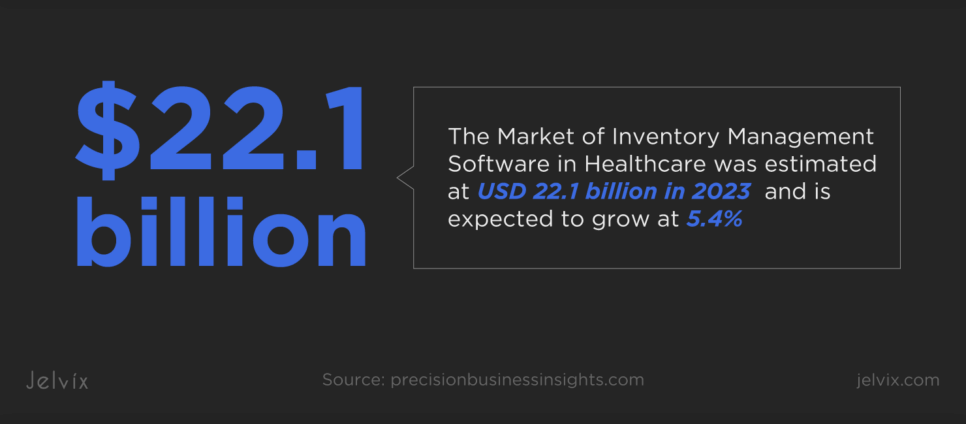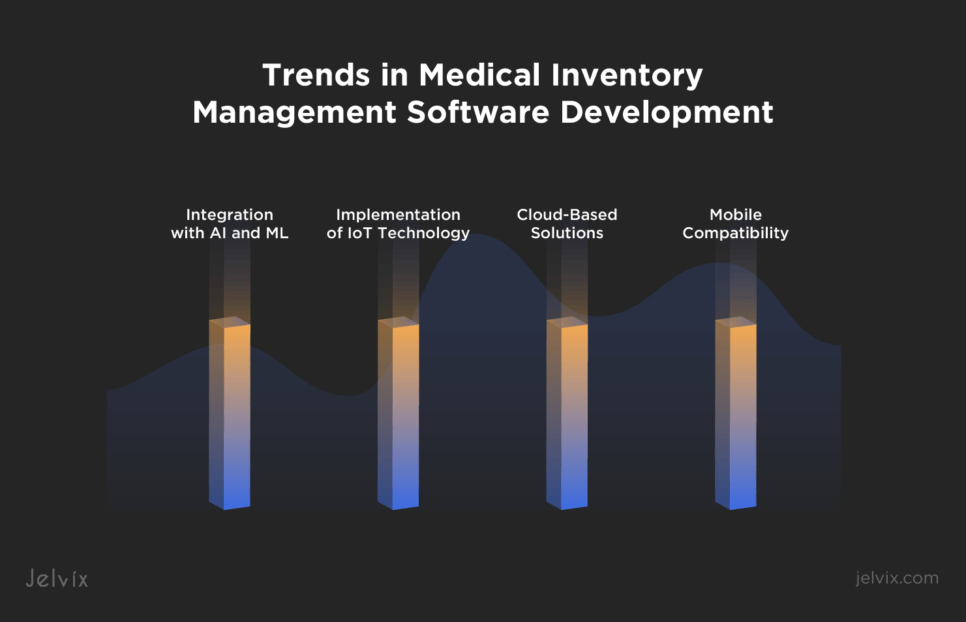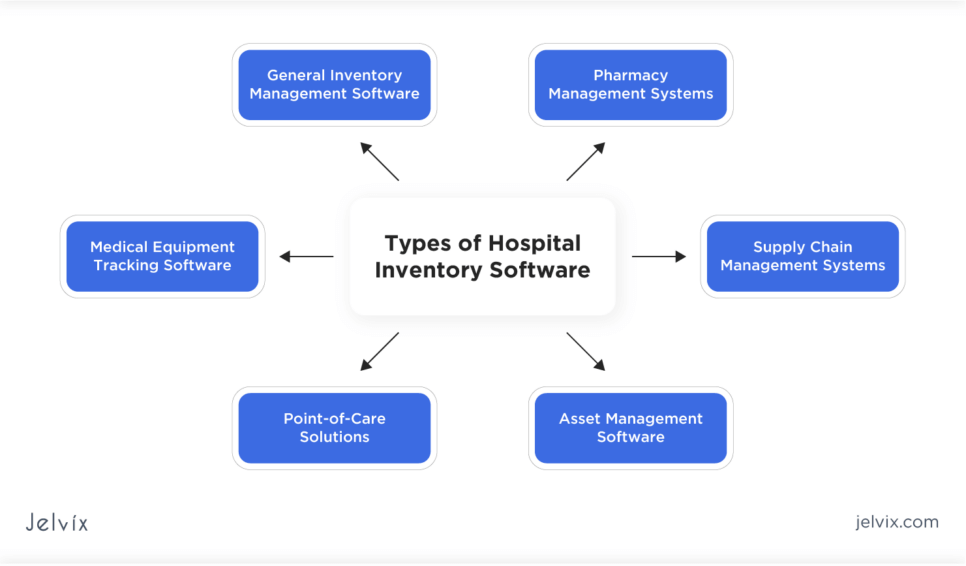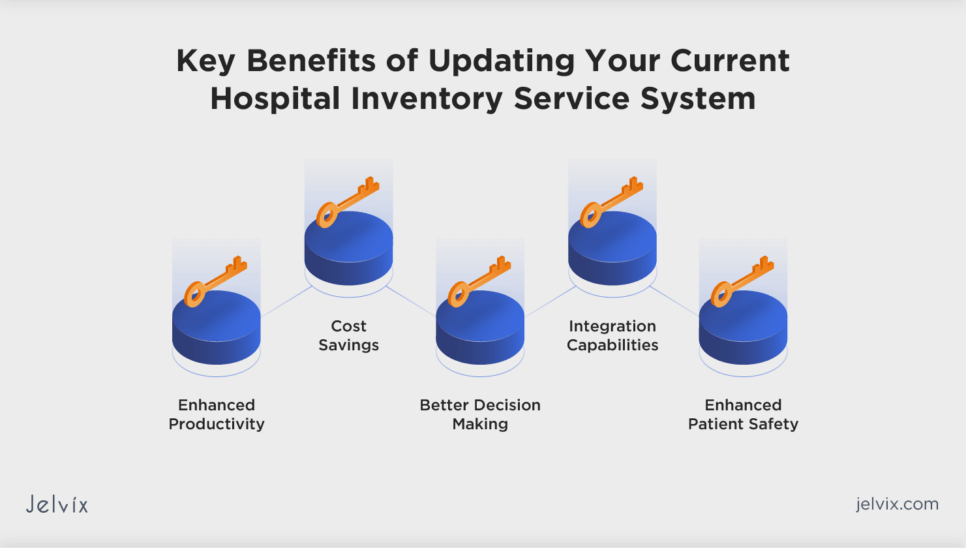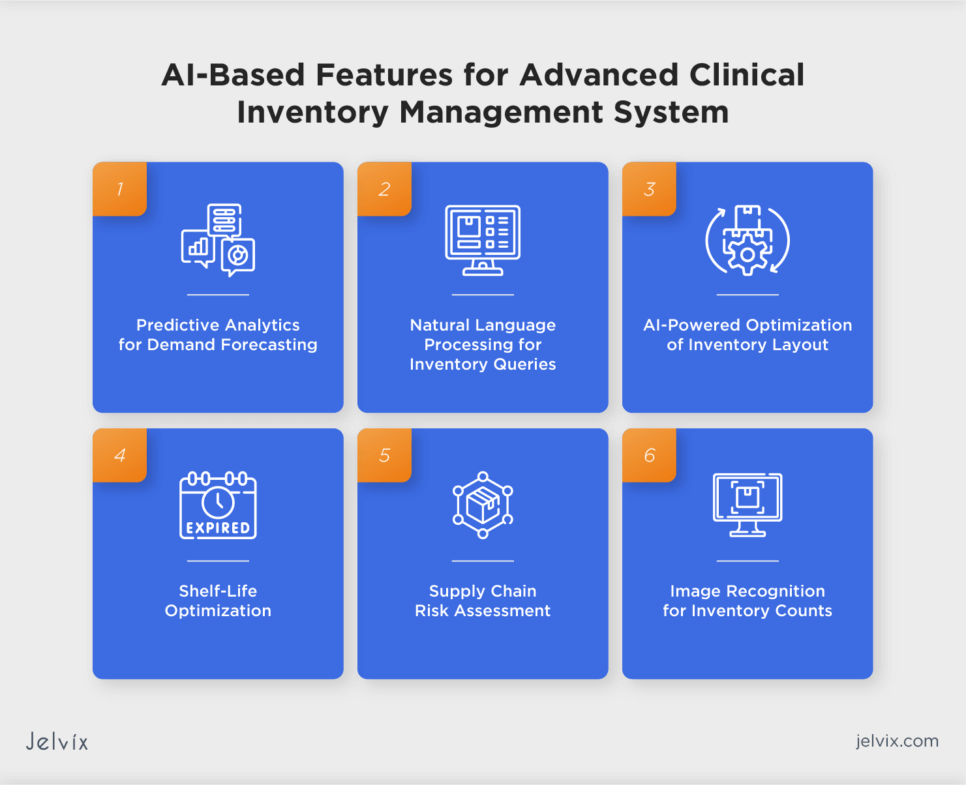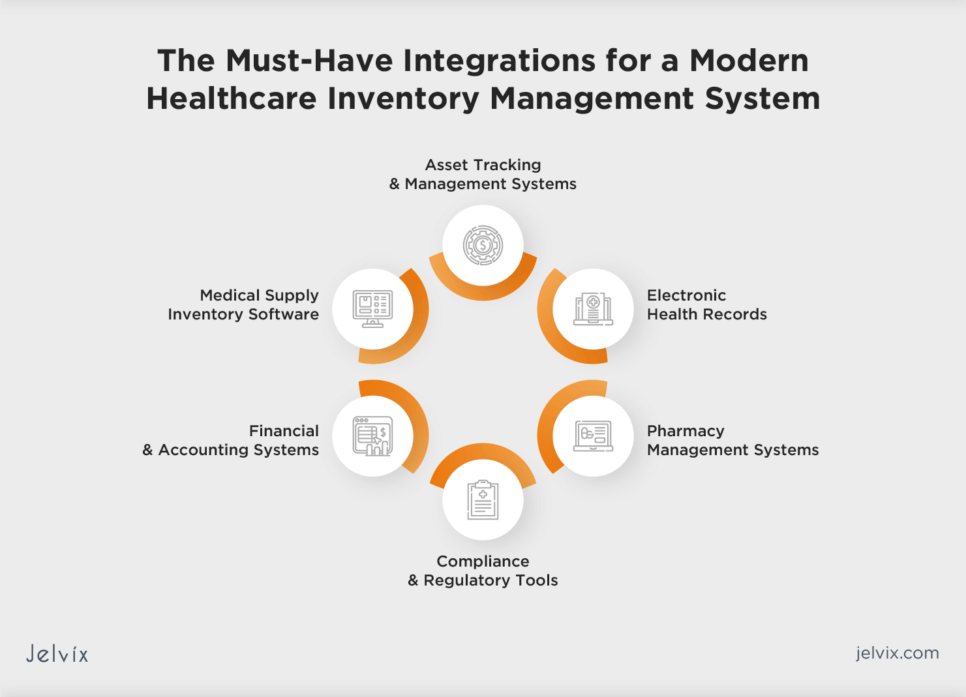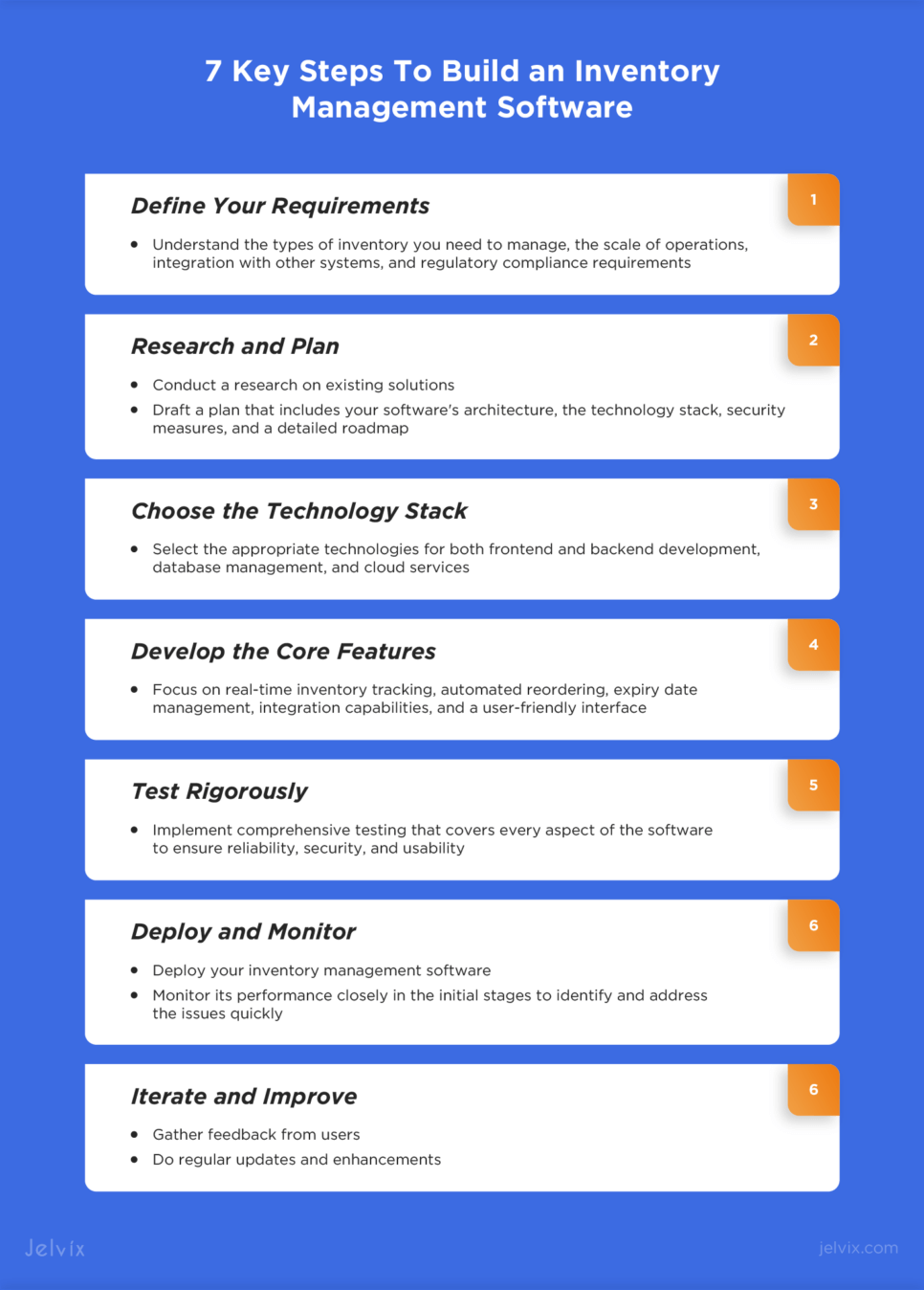Despite the significant development of healthcare tech that has been taking place over the recent years, as many as 93% of providers struggle with product shortages. To secure their supply chains without disrupting clinical processes, clinics often rely on inventory management systems.
At the same time, there is another significant challenge. Developing an up-to-date inventory software that doesn’t blow the budget is no small feat. What’s more, using advanced tech and sticking to the industry regulations increases the costs.
If you are looking into creating a cost-effective healthcare inventory management system, read this article. You’ll find out how to choose the right type of software, what features to include, and what key steps to take for a smooth development process without your wallet taking a hit.
Trends in Medical Inventory Management Software Development
The market of inventory management software in healthcare was estimated at USD 22.1 billion in 2023 and is seen to grow 5.4% by 2030. It means that medical entities that aim to develop efficient inventory management solutions need to be aware of the latest trends in the field.
Integration with AI and ML
Artificial intelligence and machine learning have made it possible to predict inventory needs more accurately. The forecasts are based on the existing supply of the product as well as its usage in the past and current periods. Hospitals can now be confident of impending shortages or overstock and adjust orders when appropriate.
Implementation of IoT Technology
The Internet of Things technology with medical inventory management software may help in real-time tracking of inventory levels. What’s more, it aids in the automation of reordering and monitoring of storage where it is usually stored, such as refrigerated sections for vaccines or medications that need preservation.
Cloud-Based Solutions
The use of cloud computing brought about the development of scalable and flexible medical inventory control solutions. Since cloud-based software can be accessed from any location, it allows for remote inventory management and clinical interoperability among various medical environments.
Mobile Compatibility
All medical domains adopt mobile-friendly solutions, and inventory management isn’t an exception. Mobile apps allow staff to update and access inventory information on the go, facilitating agile management practices.
Types of Hospital Inventory Software
Inventory tools in healthcare software development vary by entity needs and operational scale. The right choice depends on entity size, inventory complexity, system integration needs, and budget.
General Inventory Management Software
This software handles basic tasks like tracking stock, updating records, and alerting for reorders, suitable for a broad range of hospital supplies.
Pharmacy Management Systems
These systems manage pharmaceutical stocks, handle prescriptions, and ensure regulatory compliance, which is important for monitoring medication levels and automating reorders.
Medical Equipment Tracking Software
Focused on medical equipment, this software tracks location, status, and maintenance schedules, ensuring equipment is always available when needed.
Supply Chain Management Systems
These are comprehensive solutions for overseeing the entire supply chain, including procurement, usage, optimizing orders, managing vendors, and improving efficiencies.
Point-of-Care Solutions
Designed for specific care settings, these systems manage supplies where patient care is provided, automating inventory updates and supporting billing.
Asset Management Software
It helps track the lifecycle of hospital assets, including consumables and equipment, aiding in maintenance planning and asset use.
Key Benefits of Updating Your Current Hospital Inventory Service System
Updating your current medical inventory solution can be a good idea if you aim at maximizing the benefits for your healthcare entity. A newer system can significantly impact the operational efficiency, compliance, and financial health of your company, while also enhancing the quality of patient care.
Enhanced Productivity
Modern inventory solutions automate data entry, tracking, and reordering. This automation reduces the likelihood of human error and frees up staff time for patient care, leading to improved efficiency and productivity.
Cost Savings
Upgrading an inventory system involves upfront costs, but the potential long-term financial benefits are significant. Modern solutions enable clinics to prevent overstocking, lower storage expenses, and cut losses from expired or unused items.
Better Decision Making
Modern inventory systems, equipped with advanced analytics and reporting, provide critical insights into inventory patterns, usage rates, and financial assessments. This information empowers healthcare managers to fine-tune inventory quantities and find ways to reduce expenses.
Integration Capabilities
New inventory management systems offer better CRM-EHR integration and connection with billing software. Such integration simplifies data exchange across departments, enhancing coordination and improving the overall quality of healthcare services.
Enhanced Patient Safety
By ensuring the right supplies are available at the right time and place, updated inventory systems benefit patient safety. They help manage the expiration dates of pharmaceuticals, track lot numbers for recall management, and support standardized procedures, supporting safer patient care.
Read to find out what dangers patient misidentification may pose, the ways to prevent errors in healthcare management, and types of identity technologies to implement.
Custom vs Out-of-the-Box Software for Inventory Management in Hospitals
When it comes to implementing inventory management tools, clinics often face the decision between custom-built and out-of-the-box solutions. Each option has its advantages and considerations, making the choice largely dependent on specific business needs, budget, and long-term goals.
Custom Hospital Inventory Management Software
Custom software is specifically developed to meet a company’s unique needs, offering tailored functionalities. It suits best entities with specific operational demands that ready-made solutions can’t fulfill.
Advantages of custom hospital inventory software include:
- Tailored solution: developed to meet the specific operational needs and workflows of your hospital, ensuring a perfect fit for your inventory management processes;
- Scalability: can be modified and scaled to accommodate new requirements, departments, or locations of your entity;
- Integration: can be designed to seamlessly integrate with existing hospital systems, supporting interoperability;
- Competitive edge: can provide unique features, giving your entity a competitive advantage in patient care and operational management.
Considerations for developing a custom solution:
- Cost: the development can be expensive as it requires a significant upfront investment in design, development, and testing;
- Time to implement: takes longer to develop and deploy compared to ready-made software;
- Maintenance: requires ongoing maintenance and updates, which can add to the total cost of ownership.
Out-of-the-Box Hospital Inventory Management Software
This is ready-made software available for immediate use, which makes it suitable for businesses seeking general solutions without the need for customization.
Advantages of using OOTB hospital inventory software:
- Quick deployment: can be deployed much faster than custom solutions, providing hospitals with immediate improvements in inventory management;
- Lower costs: typically involves lower upfront costs, making it an attractive option for facilities with limited budgets;
- Proven reliability: was tested across multiple deployments, offering proven reliability and stability right from the start;
- Ongoing support: vendors often provide support and regular updates, ensuring the system offers the latest features and security measures.
Key considerations include:
- Generic features: may not perfectly align with your hospital’s workflows or inventory management needs;
- Limited customization: while some level of customization might be possible, the scope is usually limited;
- Potential for additional costs: can involve ongoing subscription fees, licensing costs, or charges for additional features.
To pick the right inventory management software for your hospital, first identify your needs and workflow fit. Then, assess your budget and future costs. Lastly, ensure it meets long-term goals and can adapt to changes.
Killer Features of Inventory Management System To Look for in 2024
Developing a hospital inventory management system requires a thoughtful approach to ensure it meets the needs of your healthcare entity. Including the must-have features can enhance the system’s effectiveness, improve operational efficiencies, and ensure patient safety.
Real-Time Inventory Tracking
Implement RFID or barcode scanning for instant updates on stock levels, location, and movement of supplies. This feature allows for accurate and real-time tracking, reducing the risk of overstocking, and ensuring the availability of critical supplies.
Automated Reordering
Integrate an automated reordering system that triggers purchase orders based on predefined minimum stock levels. This ensures essential items are always in stock without manual intervention.
Expiry Date Management
This feature tracks the expiry dates of medications and supplies, alerting staff when items are nearing expiration. This helps in using supplies efficiently and reducing waste due to expired products.
Analytics and Reporting
Incorporate advanced analytics for detailed insights into inventory trends, usage patterns, and cost analysis. Customizable reports can support decision-making, budgeting, and compliance efforts.
Integration Capabilities
Ensure the system can seamlessly integrate with other systems, such as EHRs and billing software. Integration will help enhance data accuracy, optimize workflows, and improve patient care.
User-Friendly Interface
A simple and intuitive interface is needed to ensure the ease of use. Design the system with the end-user in mind, focusing on minimizing training time and maximizing adoption rates.
Mobile Accessibility
Provide a mobile app to allow staff to manage and view inventory from anywhere and anytime. This will enhance flexibility and responsiveness in inventory management.
Customizable Alerts and Notifications
Offer customizable alerts for low stock levels, pending expiration dates, and other critical inventory events. Tailor notification according to the roles and responsibilities of different staff members.
Cloud-Based Deployment
A cloud-based system offers scalability, data security, and remote access without the need for extensive in-house IT infrastructure. It will facilitate easy updates and maintenance.
Security and Compliance
Implement robust security measures, including data encryption and multi-factor user authentication, to protect sensitive medical information. Ensure the system complies with healthcare regulations like HIPAA and GDPR.
By including these features in your hospital inventory management system, you can create a powerful tool that addresses the key challenges of managing hospital inventories.
AI-Based Features for Advanced Clinical Inventory Management System
If you are considering building a custom hospital inventory management system, think about enhancing it with advanced AI features for better accuracy, efficiency, and insights.
Predictive Analytics for Demand Forecasting
Use predictive analytics methods like regression and time series analysis to analyze historical inventory data, usage patterns, seasonal trends, and external factors to predict future inventory requirements and maintain optimal stock levels.
Natural Language Processing for Inventory Queries
Incorporate NLP to allow staff to make inventory inquiries using voice commands. This can streamline the process of finding stock information and save time for healthcare professionals.
AI-Powered Optimization of Inventory Layout
Use AI to analyze inventory movement and usage data to recommend the most efficient layout for storage areas.
Shelf-Life Optimization
Develop algorithms that dynamically adjust inventory levels based on the shelf-life of products, prioritizing the use of items that are closer to their expiration dates.
Supply Chain Risk Assessment
Use AI to assess risks in the supply chain, such as vendor reliability, geopolitical factors, or transportation issues, and recommend mitigation strategies. This will help avoid potential supply disruptions.
Image Recognition for Inventory Counts
Implement image recognition technology to automate the counting and identification of inventory items. This can significantly speed up the inventory audit process and improve its accuracy.
The Must-Have Integrations for a Modern Healthcare Inventory Management System
To maximize its efficiency, your healthcare inventory management system should seamlessly integrate with key medical and financial systems across your settings.
Electronic Health Records
The integration with EHRs connects inventory usage directly with patient care documentation, automating billing and updating patient records with real-time inventory levels.
Medical Supply Inventory Software
Harvard Business Review reports that digitizing the supply chain can reduce process costs by 50%. TheAn integration with modern supply chain systems can facilitate automatic reordering and order tracking, ensuring smooth supply chain operations.
Financial and Accounting Systems
Such integration automates financial tracking of inventory costs, supports budgeting, and enables detailed cost analysis for better financial management.
Pharmacy Management Systems
This integration is preferable for facilities with in-house pharmacies, ensuring medication inventory is accurately managed, dispensed, and billed.
Asset Tracking and Management Systems
Such integration monitors medical equipment alongside consumable supplies, maintaining records on equipment status, location, and maintenance schedules.
Compliance and Regulatory Reporting Tools
This integration helps ensure adherence to healthcare regulations, supports audit trails, and facilitates regulatory reporting.
Key Technologies and Tech Stack To Develop an Inventory Management Solution
Building robust healthcare inventory management software requires a thoughtful selection of technologies and tools. Based on vast expertise in medical software development, the Jelvix team recommends using the tech stack listed below.
Frontend Technologies
Consider using JavaScript to build the foundation of interactive web interfaces. Employ React or Angular to create dynamic and responsive user interfaces, enhancing the user experience with their high-performance architecture.
Backend Technologies
Node.js is efficient in building scalable network applications, while Python is known for its efficiency in backend development and data analysis tasks. Java is also a strong contender, especially valued for its robustness and scalability.
Database Technologies
Choose between MySQL or PostgreSQL for managing structured inventory data within a relational database framework. You can also opt for MongoDB for greater flexibility in handling unstructured data and speed in processing large volumes of information.
Cloud Platforms
Cloud services, such as AWS, Google Cloud Platform, and Microsoft Azure, offer vast infrastructure, machine learning features, and a wide range of cloud services, including AI and IoT, for sophisticated inventory analysis and tracking.
Mobile Development
Use Swift for iOS applications to benefit from its features and intuitive syntax. Kotlin is preferred for Android development due to its safety, conciseness, and full support from Google. You can also use Flutter for hybrid development for iOS/Android.
Integration
Implement RESTful APIs to enable efficient communication between the inventory management software and other healthcare systems.
Security Technologies
Secure your application using OAuth and JWT for robust authentication mechanisms, and employ SSL/TLS protocols for encrypting data transmissions, protecting sensitive information from unauthorized access.
DevOps Tools
Adopt Docker for containerization to simplify the deployment and scaling of applications across environments. Kubernetes offers automation in deploying, scaling, and operating application containers, while Jenkins helps facilitate continuous integration, optimizing the development lifecycle.
7 Key Steps To Build an Inventory Management Software
Building effective inventory management software for healthcare facilities involves a series of strategic steps that will help develop efficient software within the set budget.
1. Define Your Requirements
Start by identifying the specific needs of your healthcare company. Understand the types of inventory you need to manage, the scale of operations, integration with other systems, and regulatory compliance requirements.
2. Research and Plan
Conduct careful research on existing solutions to identify what works well and what needs improvement. Draft a detailed plan that includes your software’s architecture, the technology stack, security measures, and a roadmap that outlines each phase of development, testing, and deployment.
3. Choose the Technology Stack
Select the appropriate technologies for both frontend and backend development, database management, cloud services, and any other tools or platforms needed. The choice should support the software’s scalability, performance, and integration capabilities.
4. Develop the Core Features
Start developing the core functionalities of your inventory management software. Focus on real-time inventory tracking, automated reordering, expiry date management, integration capabilities, and a user-friendly interface.
5. Test Rigorously
Implement comprehensive testing methodologies, including unit, integration, user acceptance, and other types of testing. Testing should cover every aspect of the software to ensure reliability, security, and usability. Pay special attention to data accuracy and system integrations.
6. Deploy and Monitor
Once testing is complete, deploy your inventory management software. Monitor its performance closely in the initial stages to identify and address the issues quickly. Ensure support is available to address any technical challenges and user queries.
7. Iterate and Improve
Gather feedback from users, monitor how the software is being used, and identify areas for improvement or additional features. Regular updates and enhancements will help maintain the software’s relevance and effectiveness.
Inventory Management Software Development Cost
The cost of developing inventory management software depends on system complexity, technology choice, customization level, and whether the project is in-house or outsourced.
Complexity and Features
The more complex the software, with advanced features like AI-driven analytics, RFID integration, and real-time supply tracking, the higher the development cost is. Basic systems with standard inventory tracking and reporting functionalities are less expensive.
Technology Stack
The choice of technologies significantly impacts the cost. Open-source tools may reduce upfront costs, but consider long-term maintenance and scalability.
Customization
Customizing the software to fit specific workflows, integrate with existing systems, and meet unique regulatory requirements adds to the development effort and cost.
Development Approach
In-house development teams offer greater control but can be more costly due to the need for diverse expertise. Outsourcing to specialized agencies can be cost-effective, especially if they have pre-built components that can be customized for your needs.
Security and Compliance
Ensuring data security and compliance with healthcare regulations is essential but can increase development costs due to the need for encryption, secure data storage, and regular audits.
Maintenance and Support
Ongoing maintenance, updates, and support are important for long-term success but add to the total cost of ownership. Consider these ongoing costs when budgeting for the software.
Deployment Model
Cloud-based solutions may have lower initial costs compared to on-premise systems but consider the long-term subscription and usage-based fees.
Adopting a minimum viable product strategy can be a good idea for managing budget effectively in inventory software development. By focusing on core functionalities, MVP helps minimize the initial costs and gather user feedback for future enhancements.
How Jelvix Can Help You Build a Budget-Friendly Software
Developing an inventory management solution for healthcare needs is an essential but complicated process. Being unaware of industry trends and regulations can involve extra costs, so requesting assistance from an experienced technical partner can help align with the available budget.
At Jelvix, we specialize in developing healthcare solutions with a focus on maximizing value for every dollar spent. If you need to optimize your inventory management system or develop a new one from scratch without overspending, reach out to our managers. They will guide you through developing a tailored and budget-friendly solution.
Looking for a technology partner?
Achieve business goals with our dedicated healthcare software development team.


